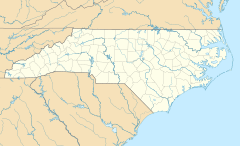Prospect, North Carolina facts for kids
Quick facts for kids
Prospect, North Carolina
|
|
|---|---|
| Country | United States |
| State | North Carolina |
| County | Robeson |
| Area | |
| • Total | 3.93 sq mi (10.17 km2) |
| • Land | 3.93 sq mi (10.17 km2) |
| • Water | 0.00 sq mi (0.00 km2) |
| Elevation | 187 ft (57 m) |
| Population
(2020)
|
|
| • Total | 873 |
| • Density | 222.25/sq mi (85.81/km2) |
| Time zone | UTC-5 (Eastern (EST)) |
| • Summer (DST) | UTC-4 (EDT) |
| FIPS code | 37-53950 |
| GNIS feature ID | 2403453 |
Prospect is a small community in Robeson County, North Carolina, United States. In 2020, about 873 people lived there. Prospect is located northeast of Pembroke.
This area is known for its strong Methodist church community. Many church members have become important voices for Native American Methodists. Prospect is also famous as the hometown of Adolph Dial. He helped people learn more about the local Lumbee Tribe and other Native Americans in the southeastern U.S.
Contents
Where is Prospect?
Prospect is a "census-designated place" (CDP). This means it's a community that the government counts for population, but it's not officially a city or town.
The community covers about 3.93 square miles (10.17 square kilometers) of land. It doesn't have any water within its borders. The area is generally thought to reach east to Preston and Red Hill Roads and north to Old Maxton/Red Spring Road.
Who Lives in Prospect?
| Historical population | |||
|---|---|---|---|
| Census | Pop. | %± | |
| 2020 | 873 | — | |
| U.S. Decennial Census | |||
In 2000, there were 690 people living in Prospect. Most people (about 96%) identified as Native American. A smaller number of people were White (2%) or African American (0.14%). Some people were from other races or mixed races. About 1.6% of the population was Hispanic or Latino.
There were 239 households in 2000. Many households (38.9%) had children under 18. About 52.7% were married couples. The average household had almost three people.
The people in Prospect were of different ages. About 27.7% were under 18, and 8.6% were 65 or older. The average age was 33 years old.
How Prospect Started
Many people believe the Prospect community began when a man named Preston Locklear claimed a lot of land. This land was along an area now called the Long Swamp.
Dr. Peter H. Wood wrote a report in 1992 that said Preston Locklear was a Tuscarora person. In 1992, there were about 4,000 Tuscarora people in Robeson County, North Carolina. Preston Locklear is also listed as one of the people who helped start the University of North Carolina at Pembroke.
Churches in Prospect
Most of the churches in Prospect are Methodist churches. These include Prospect United Methodist Church, Prospect Methodist Church, New Prospect Church, and New Prospect Methodist Church.
Prospect United Methodist Church was started by Reverend W. L. Moore. He was the grandfather of Adolph Dial, who later founded the American Indian Studies department at the University of North Carolina at Pembroke.
There are only two non-Methodist churches in the community. These are Island Grove Baptist Church and Preston Gospel Chapel. Island Grove Baptist Church joined the Burnt Swamp Baptist Association in 1955. Preston Gospel Chapel was started by Scottish people around 1875.
Prospect United Methodist Church: A Community Hub
The most important church in Prospect is Prospect United Methodist Church. It's also known as "Prospect Church" and has been mentioned in newspapers since 1871.
This church is very important to the community. It has many buildings, sometimes called the "Temple," that stretch along W.L. Moore Road. This church serves the largest group of Native Americans in the United States.
Local farmers helped build the first church. This allowed people to come together in their shared space. Over the years, new buildings were added in 1865, 1876, 1895, 1946, 1961, 1970, 1976, 1987, and 1989.
The first two church buildings (1865 and 1876) were made of logs and pegs. The 1865 building also served as a one-room schoolhouse. The 1895 building, made of timber, is still standing today.
Today, Prospect United Methodist Church helps train leaders for Lumbee Methodists. Its members attend national meetings to represent the American Indian-Methodist community. The church also supports local schools and education. It offers a daily worship service for high school students. It also has the Anderson Scholarship Fund to help young people who want to work for the church.
Adolph Dial: A Lumbee Leader
Adolph Dial was a very important member of Prospect Methodist Church. He was born in Prospect in 1922. He became the first chairman of the Department of American Indian Studies at the University of North Carolina at Pembroke.
Dial became a top expert in Native American studies. He was well-known for his work with the Lumbee tribe and for historians across North Carolina and the country. He gained national attention when he served on the American Indian Policy Review Commission.
In 1971, Dial and another professor, David Eliades, received money to research the Lumbee Indians. This led to their book, The Only Land I Know: A History of the Lumbee Indians, published in 1975. This book tells the long history of the tribe from colonial times to today.
Adolph Dial's work has been honored with awards at the University of North Carolina at Pembroke. The Dial Humanities Building on the school's campus is also named after him.
Adolph Dial believed he was related to the "Lost Colonists" from John White's group, especially Virginia Dare.
Important People from Prospect
- Jimmy Goins, who was the Chairman of the Lumbee Tribe from 2004 to 2010.
See also
 In Spanish: Prospect (Carolina del Norte) para niños
In Spanish: Prospect (Carolina del Norte) para niños


